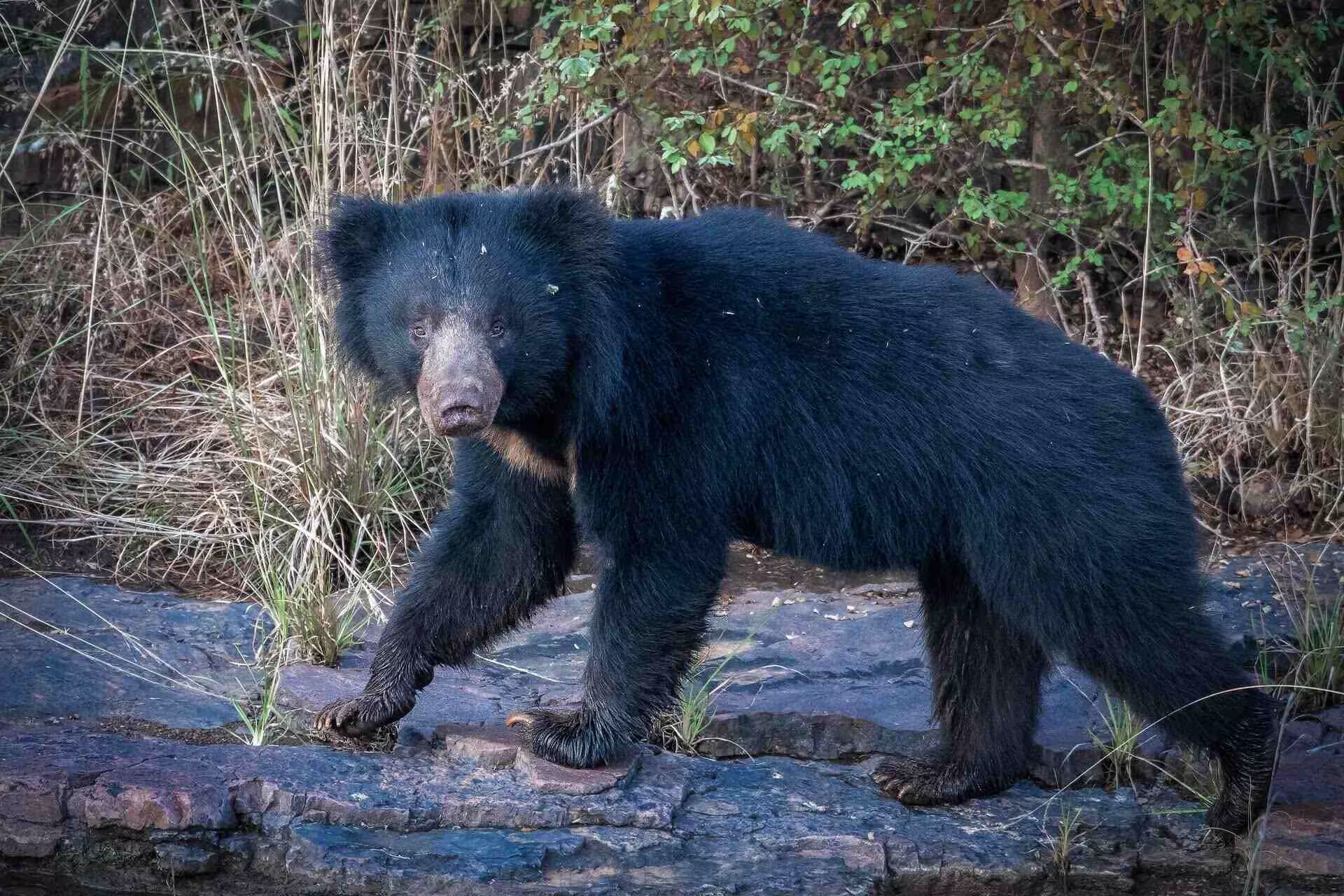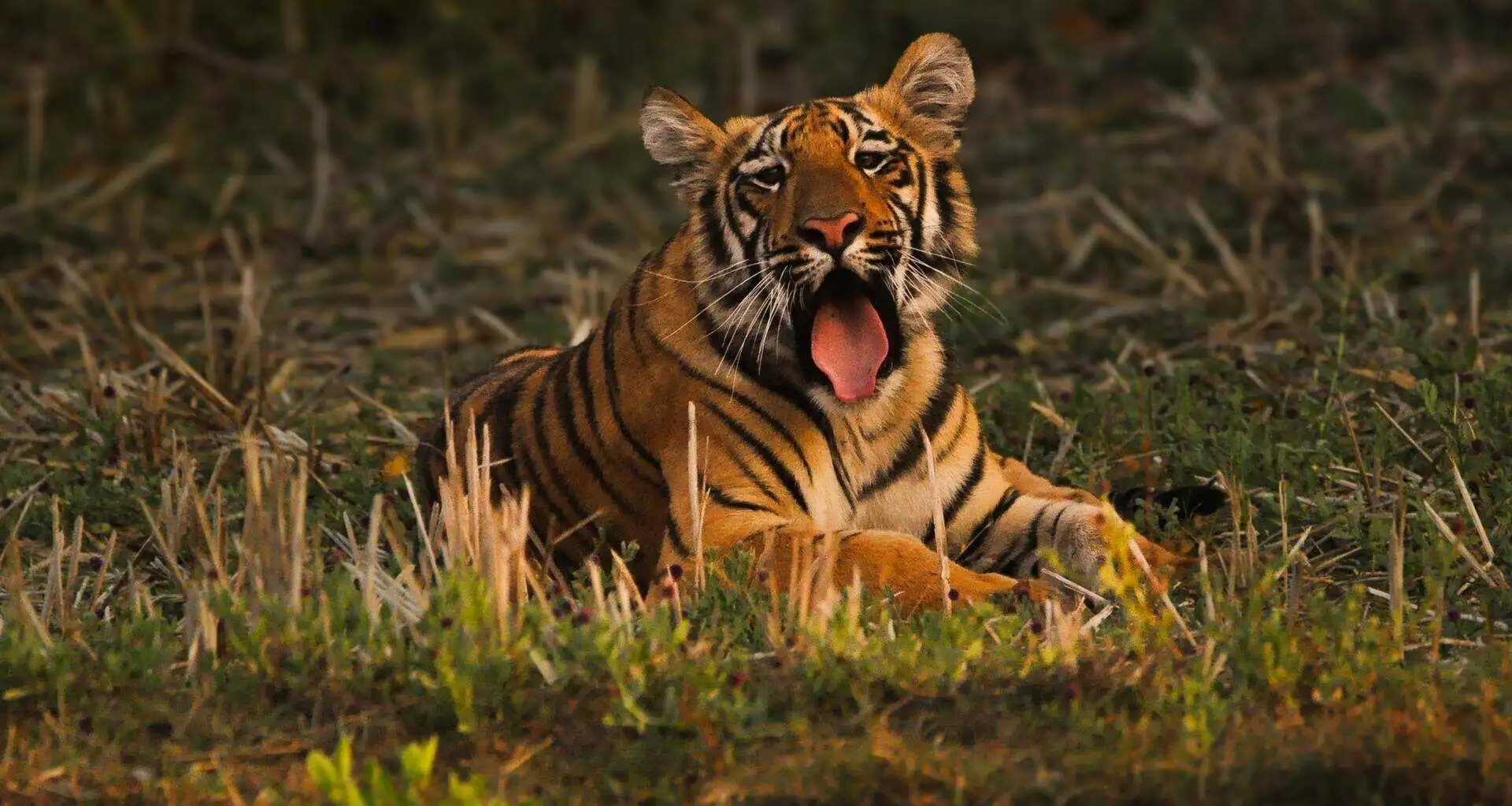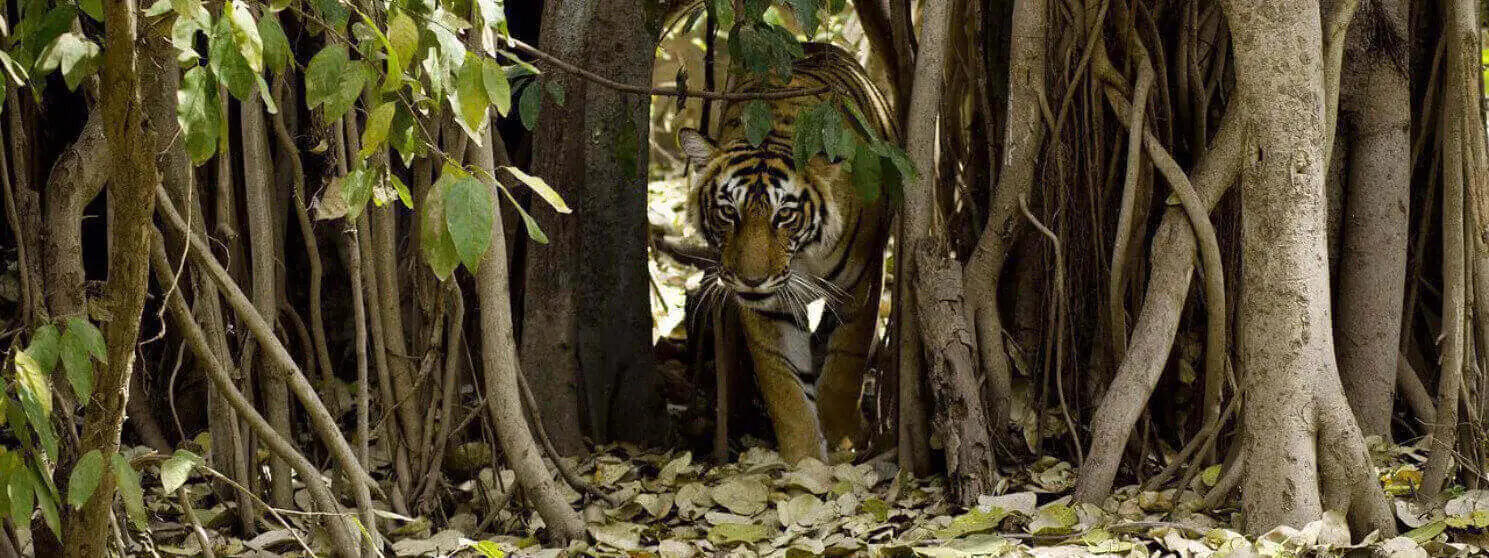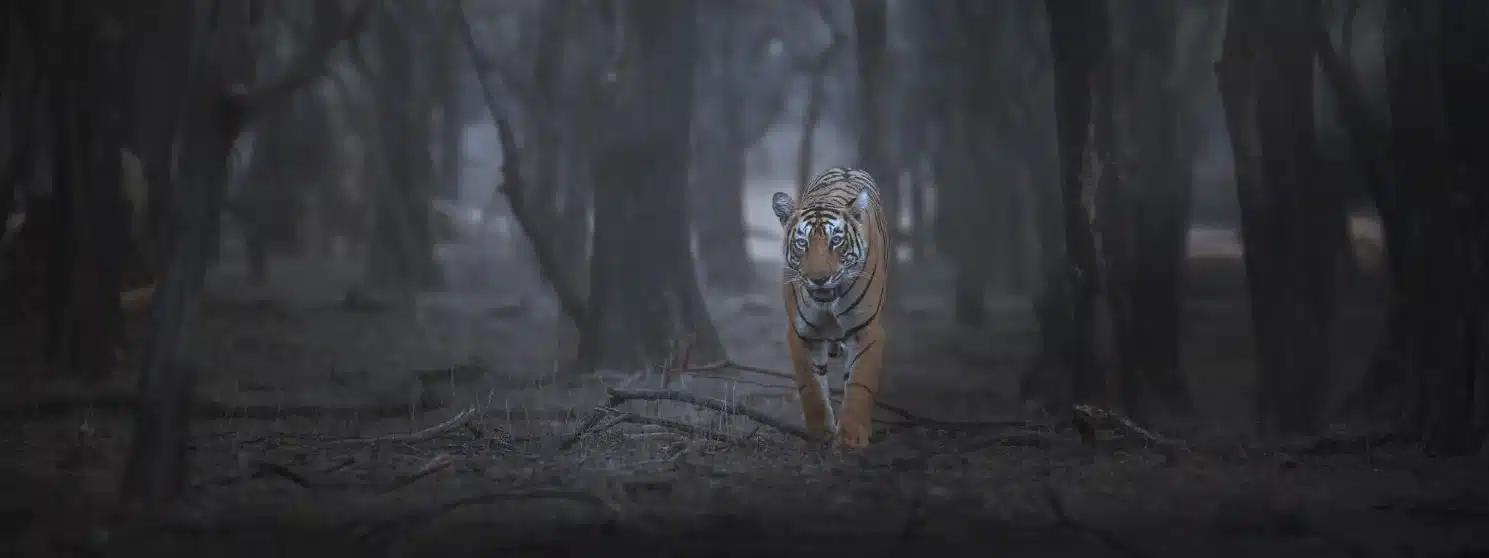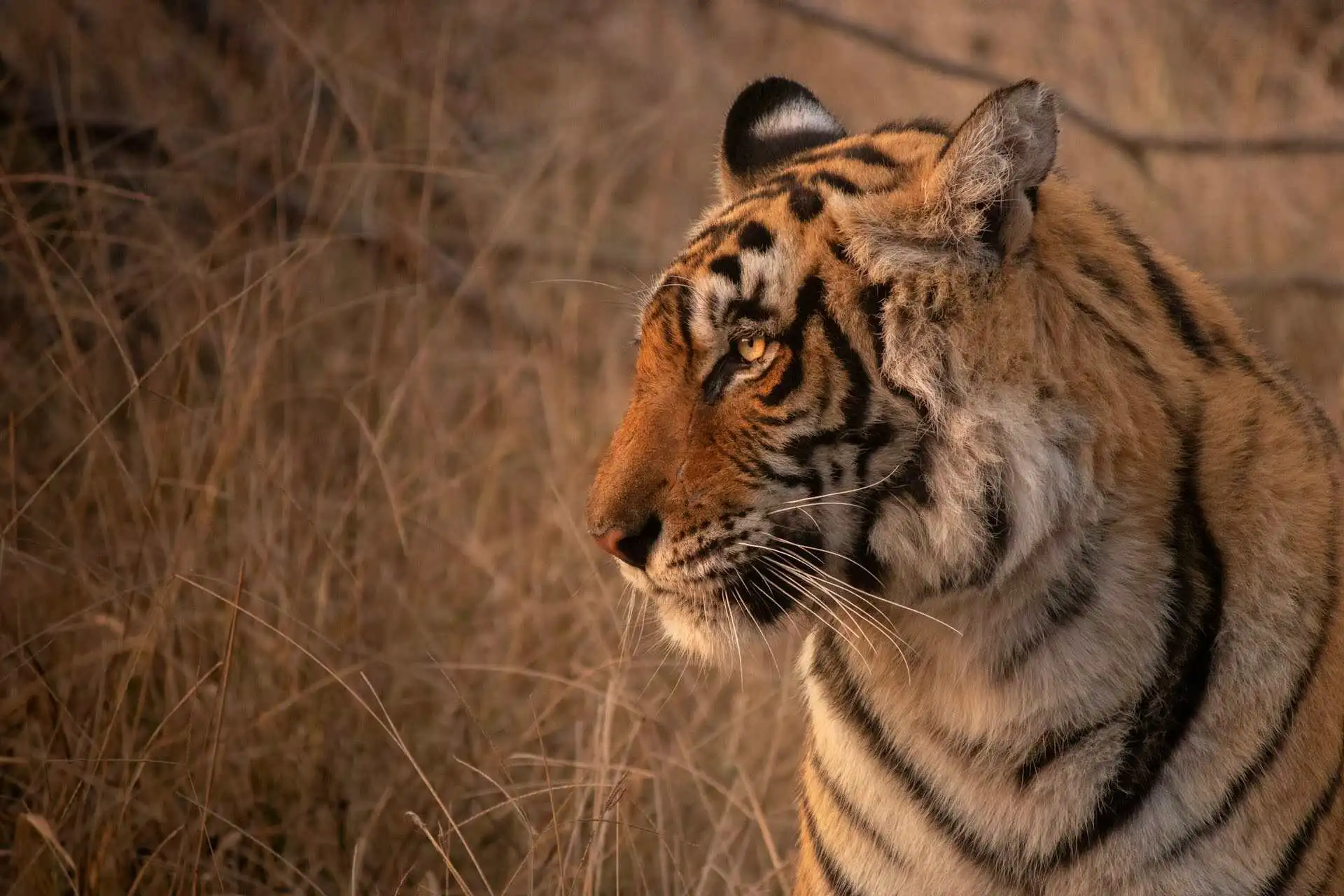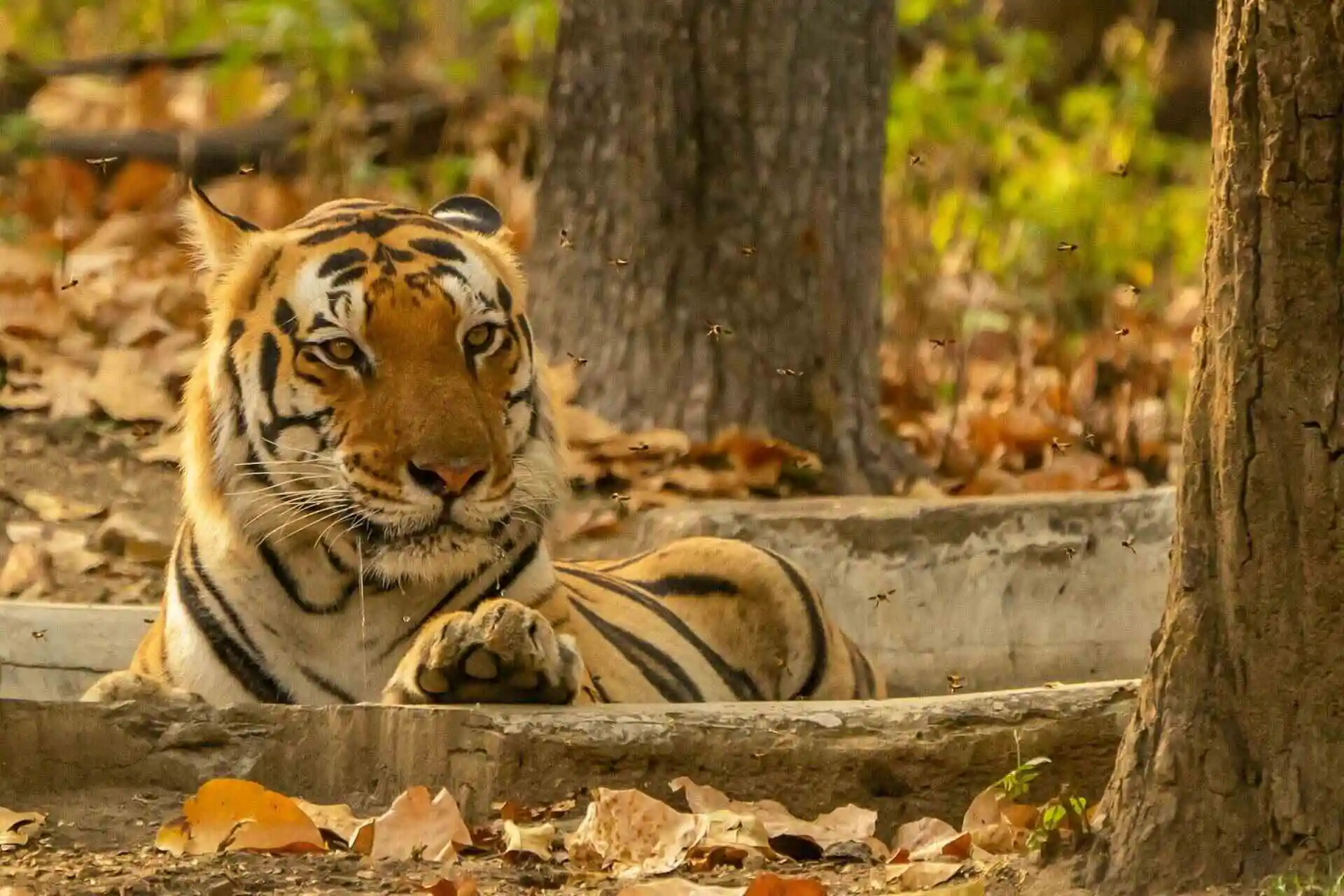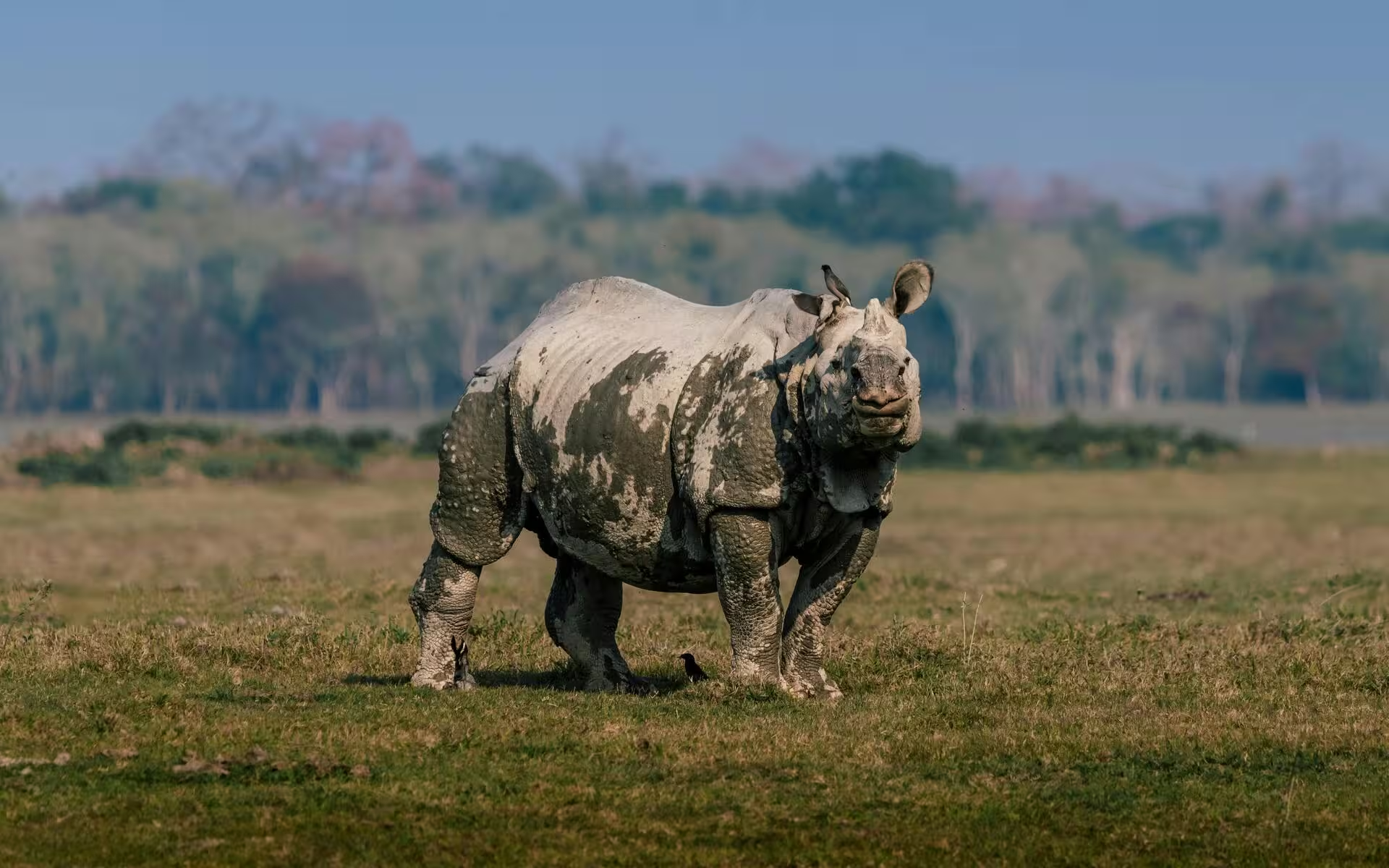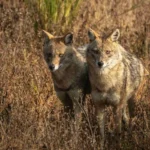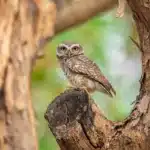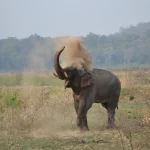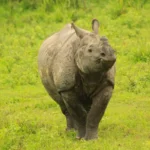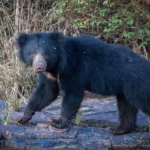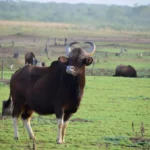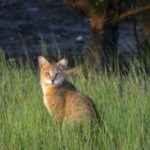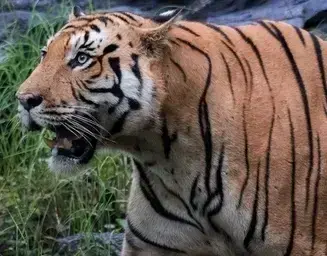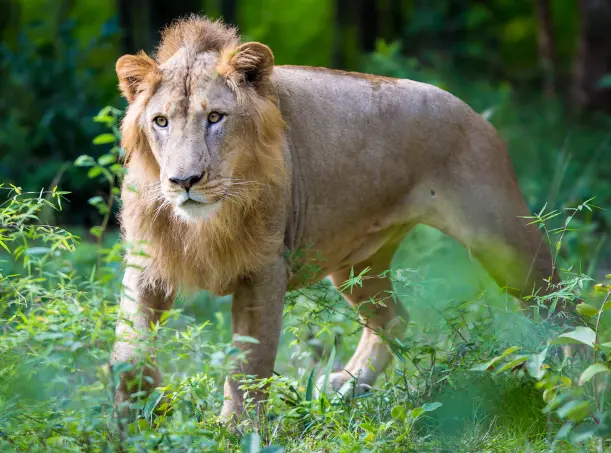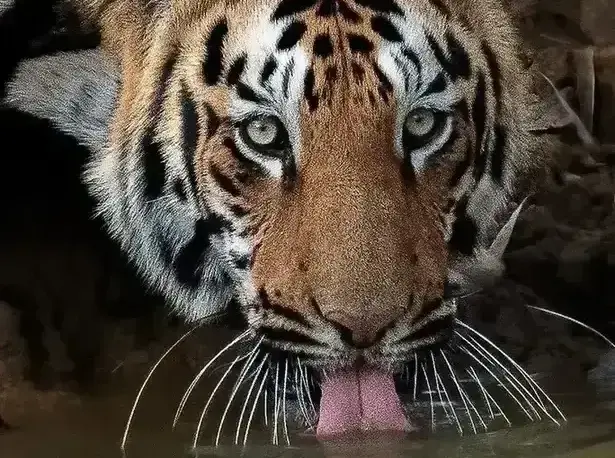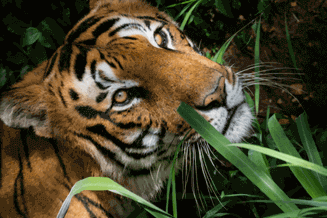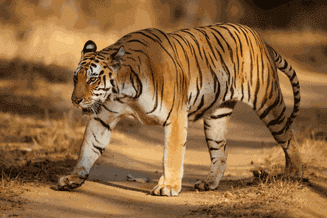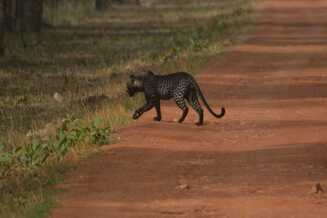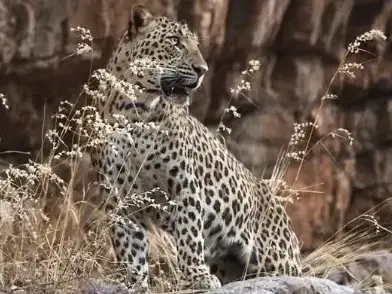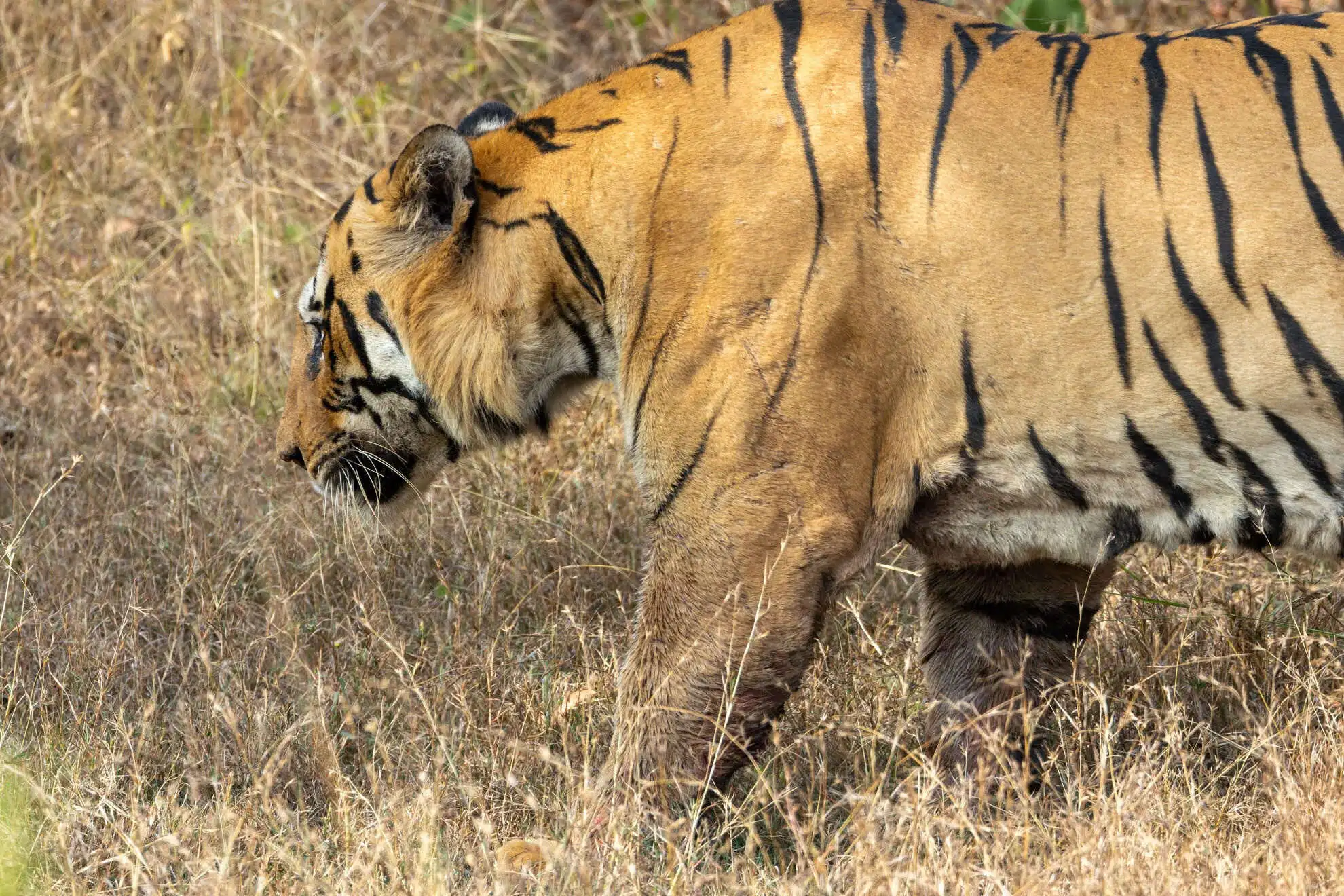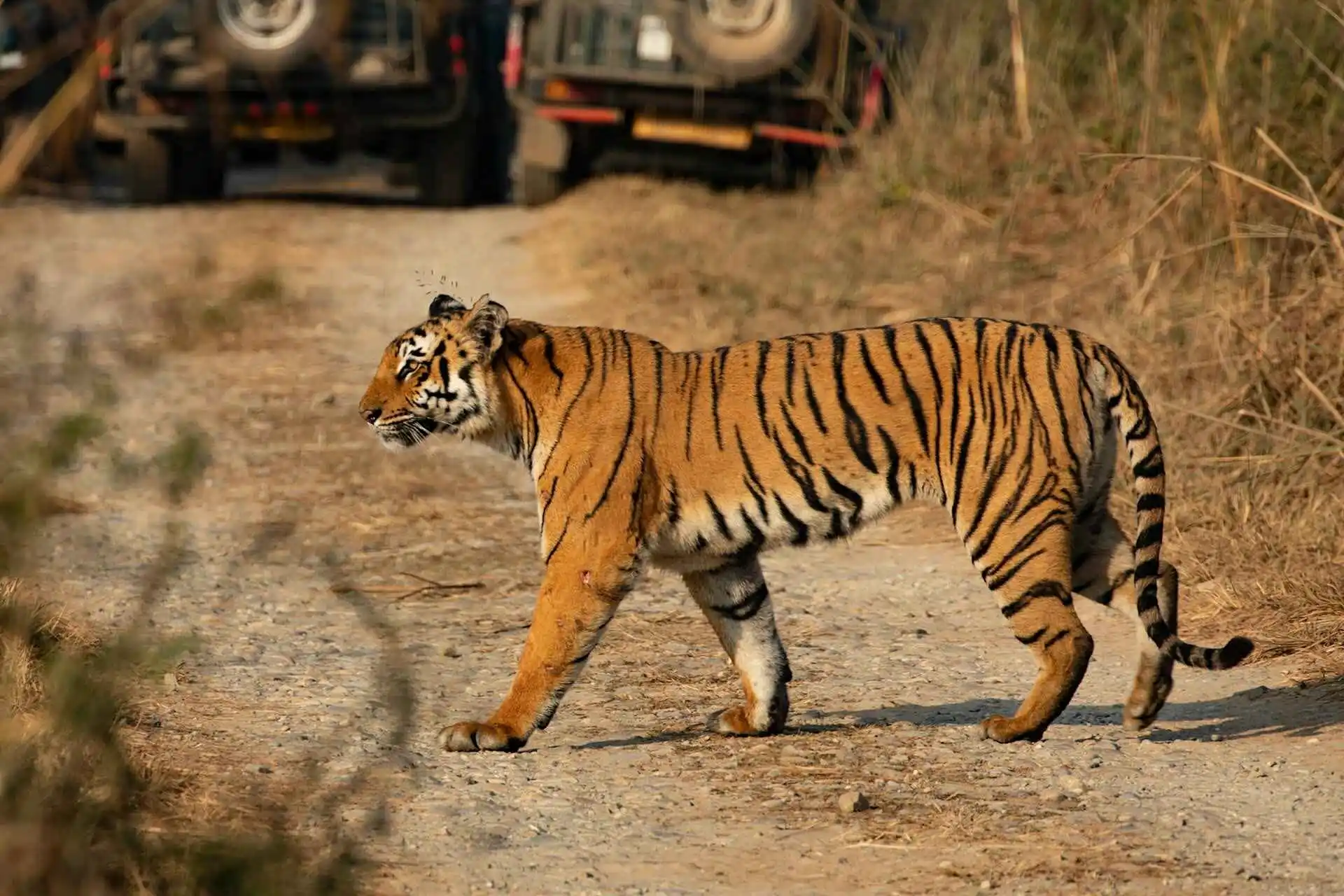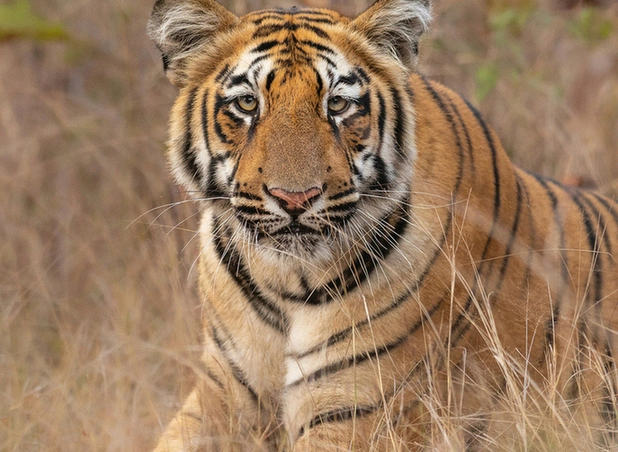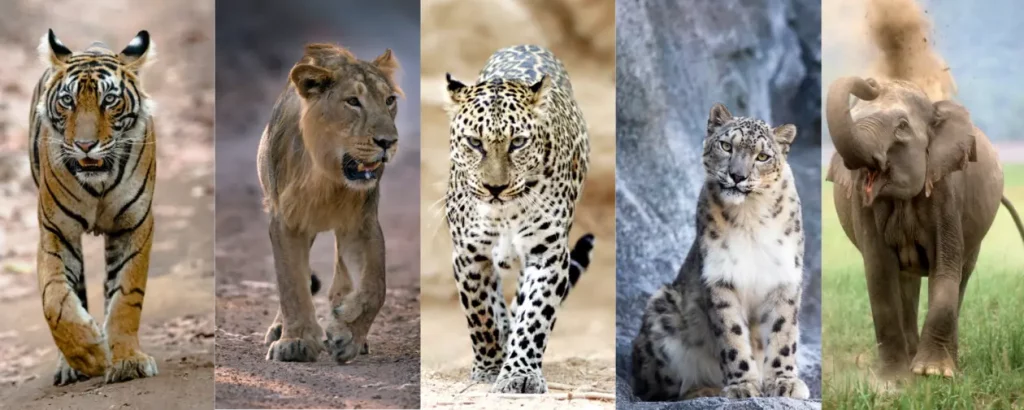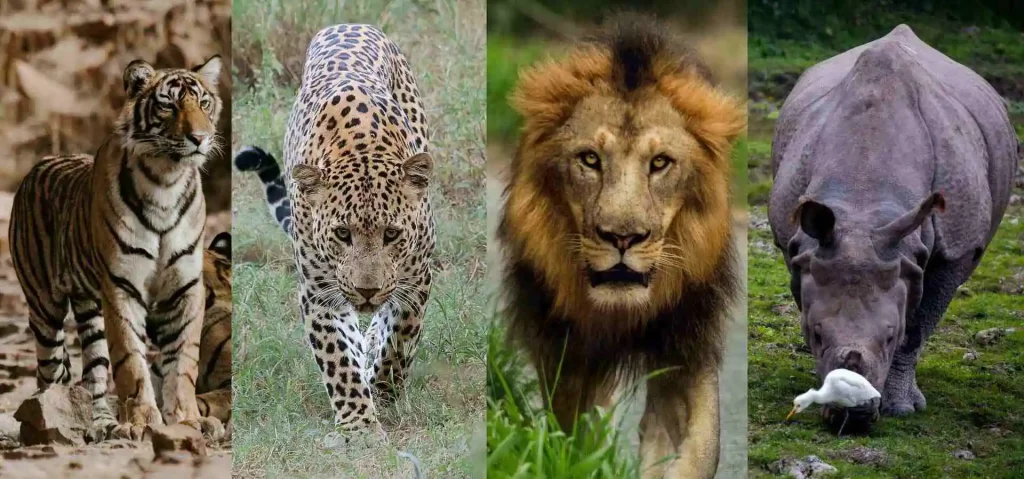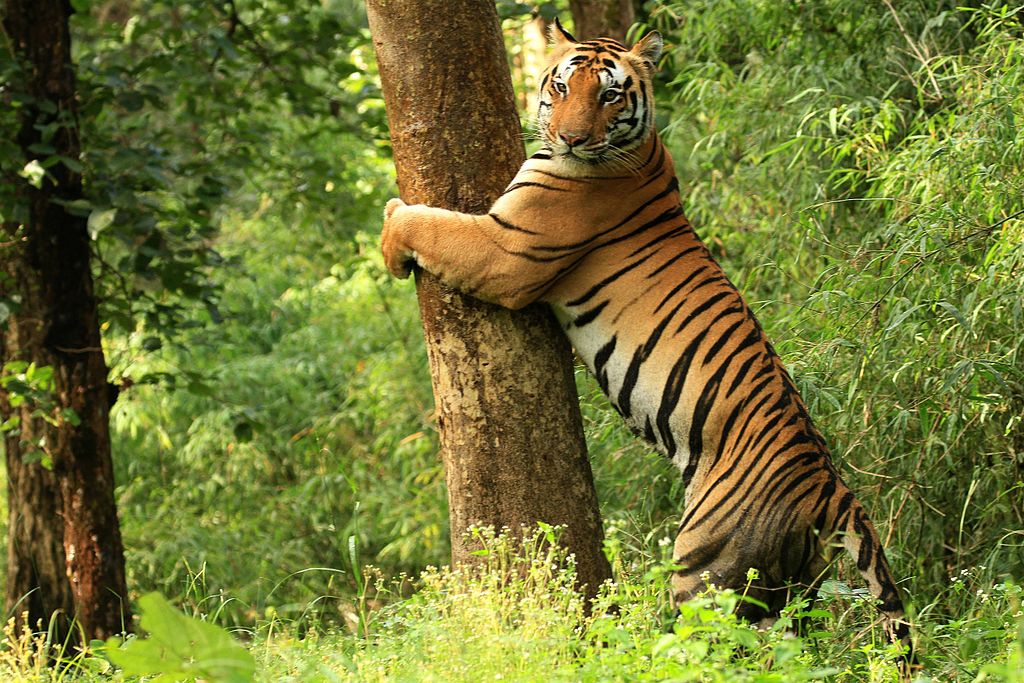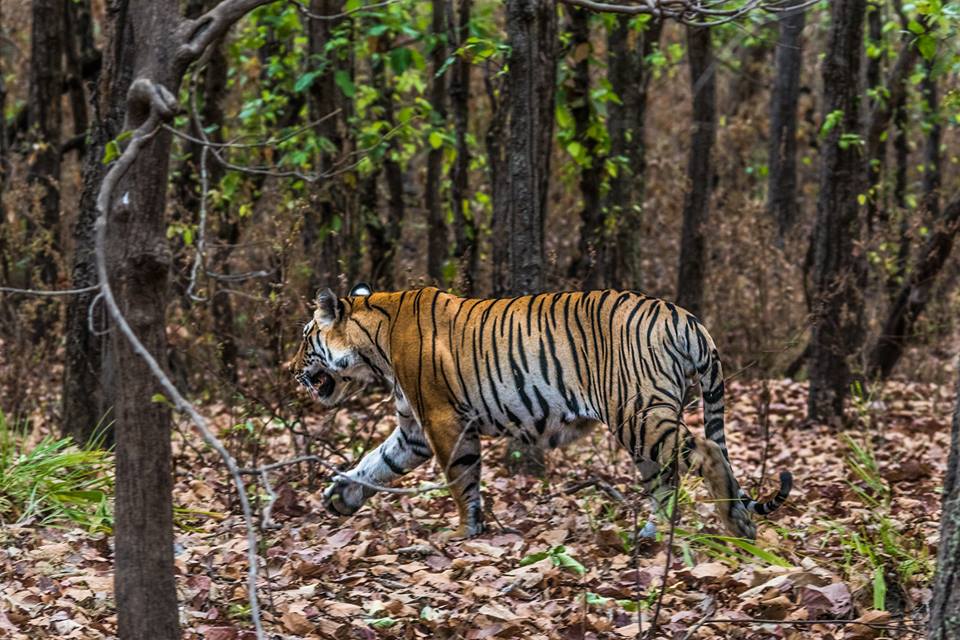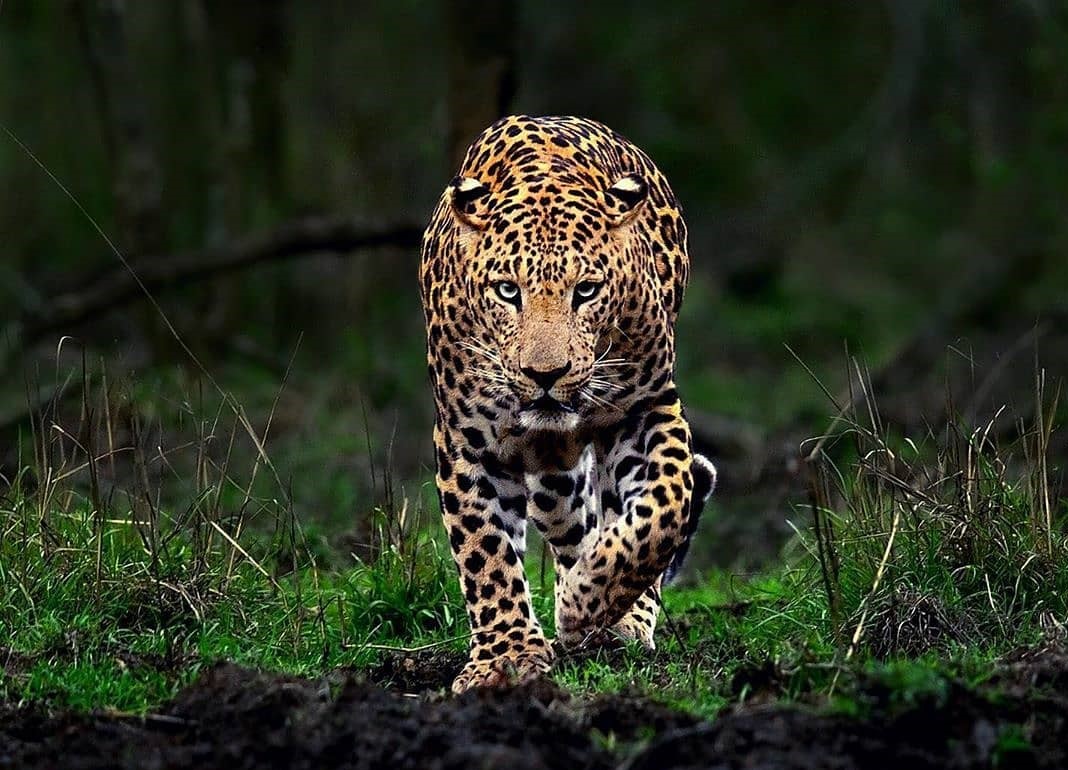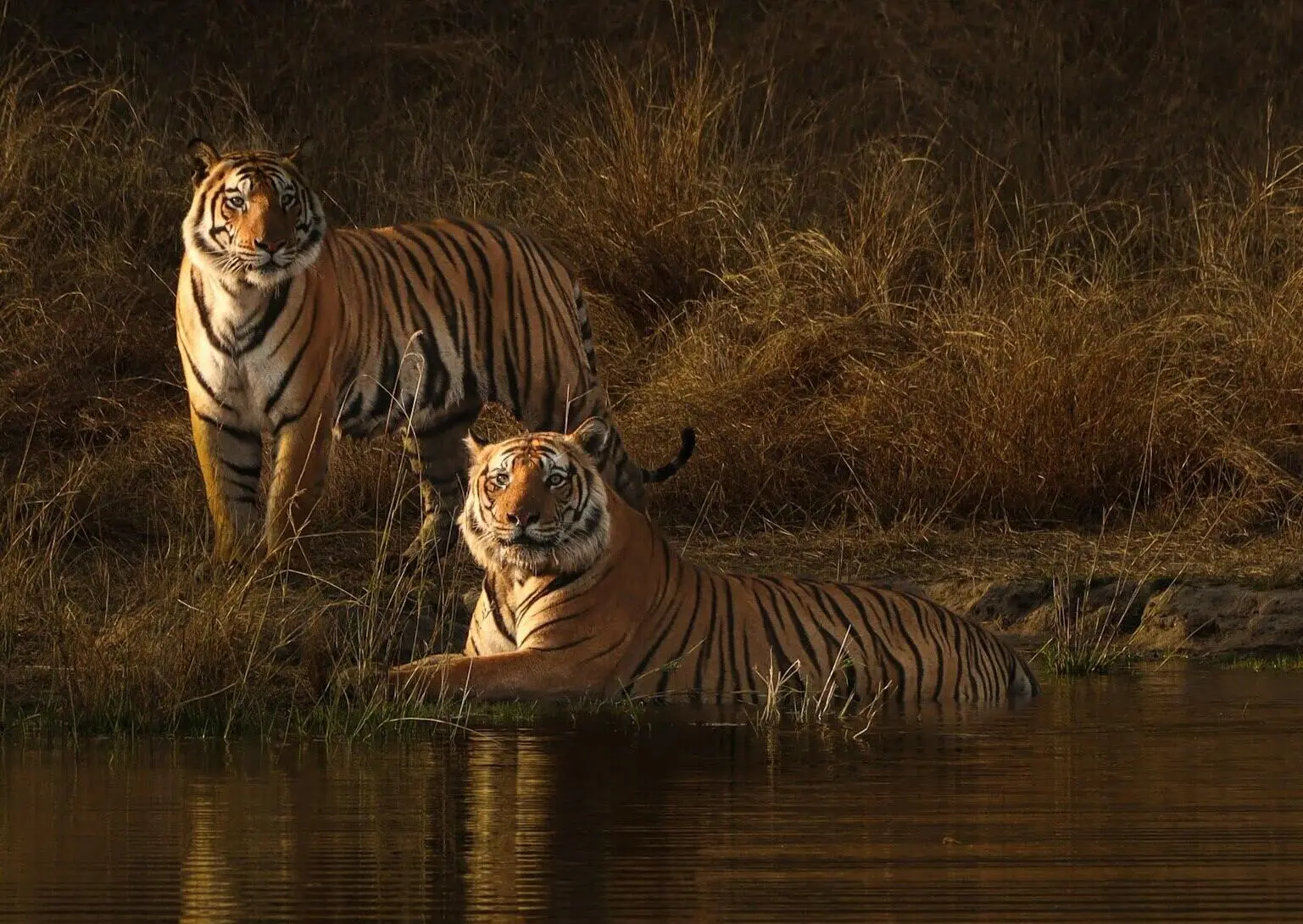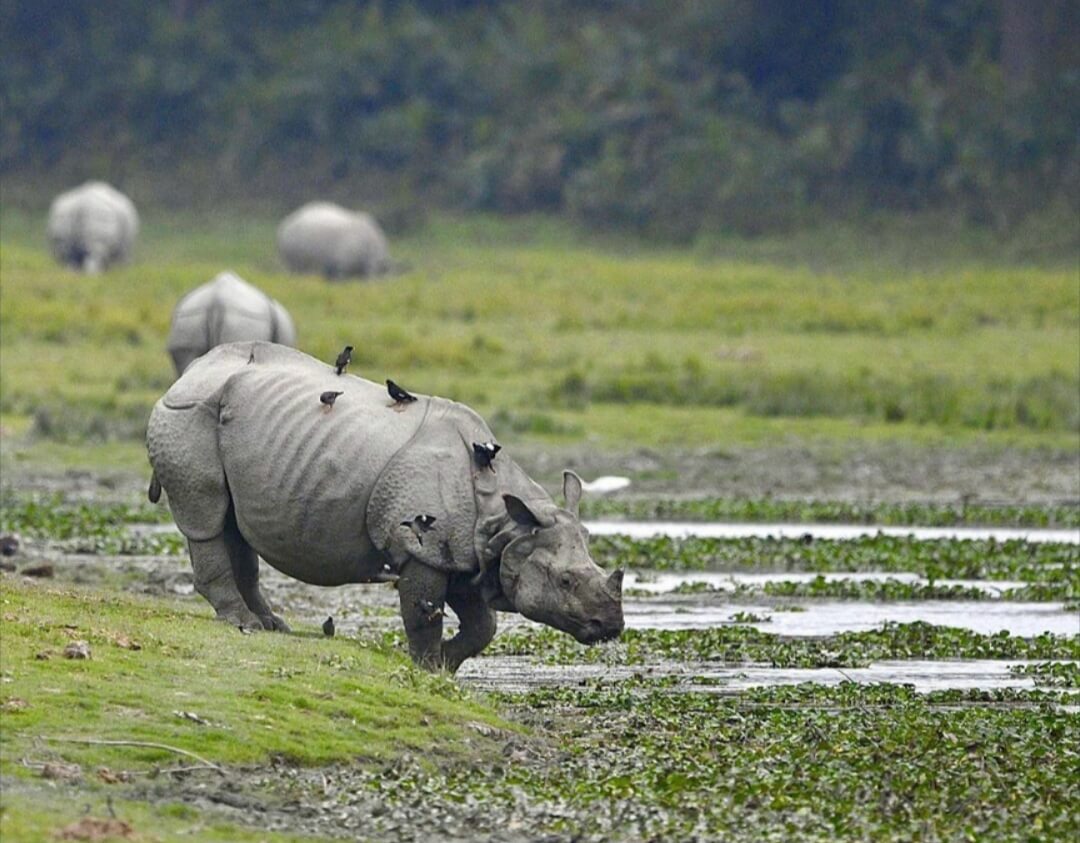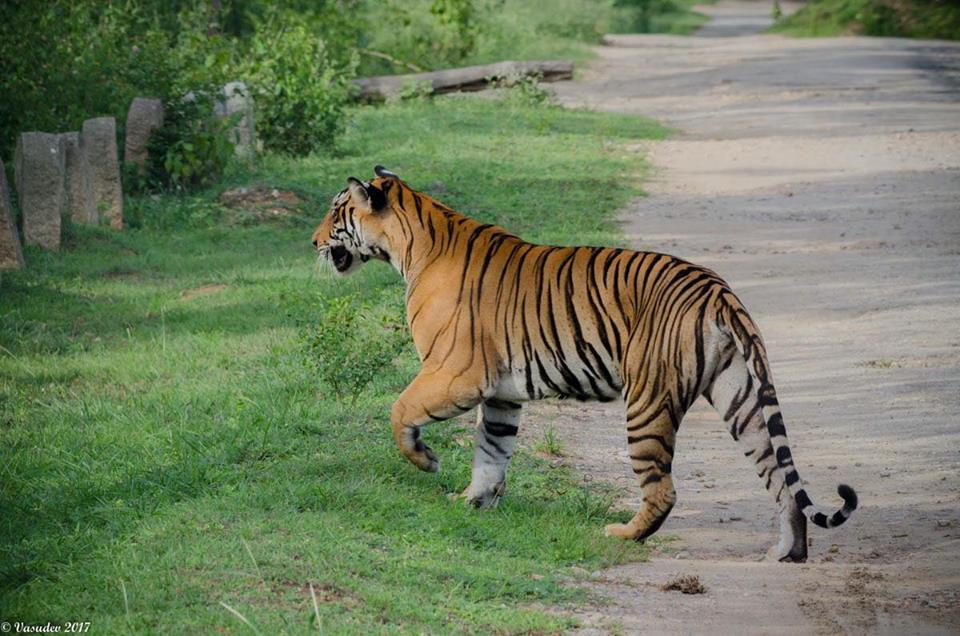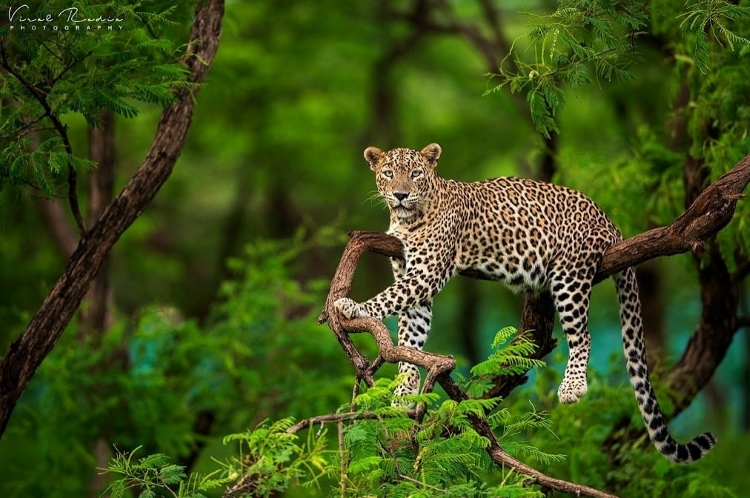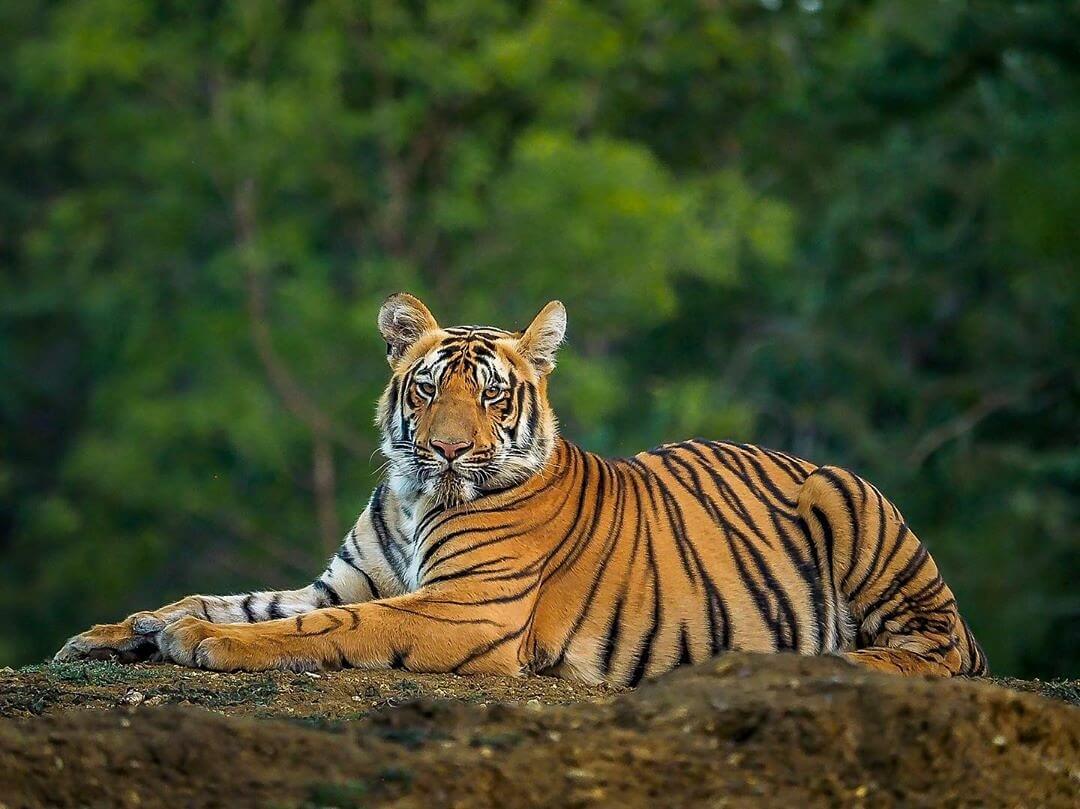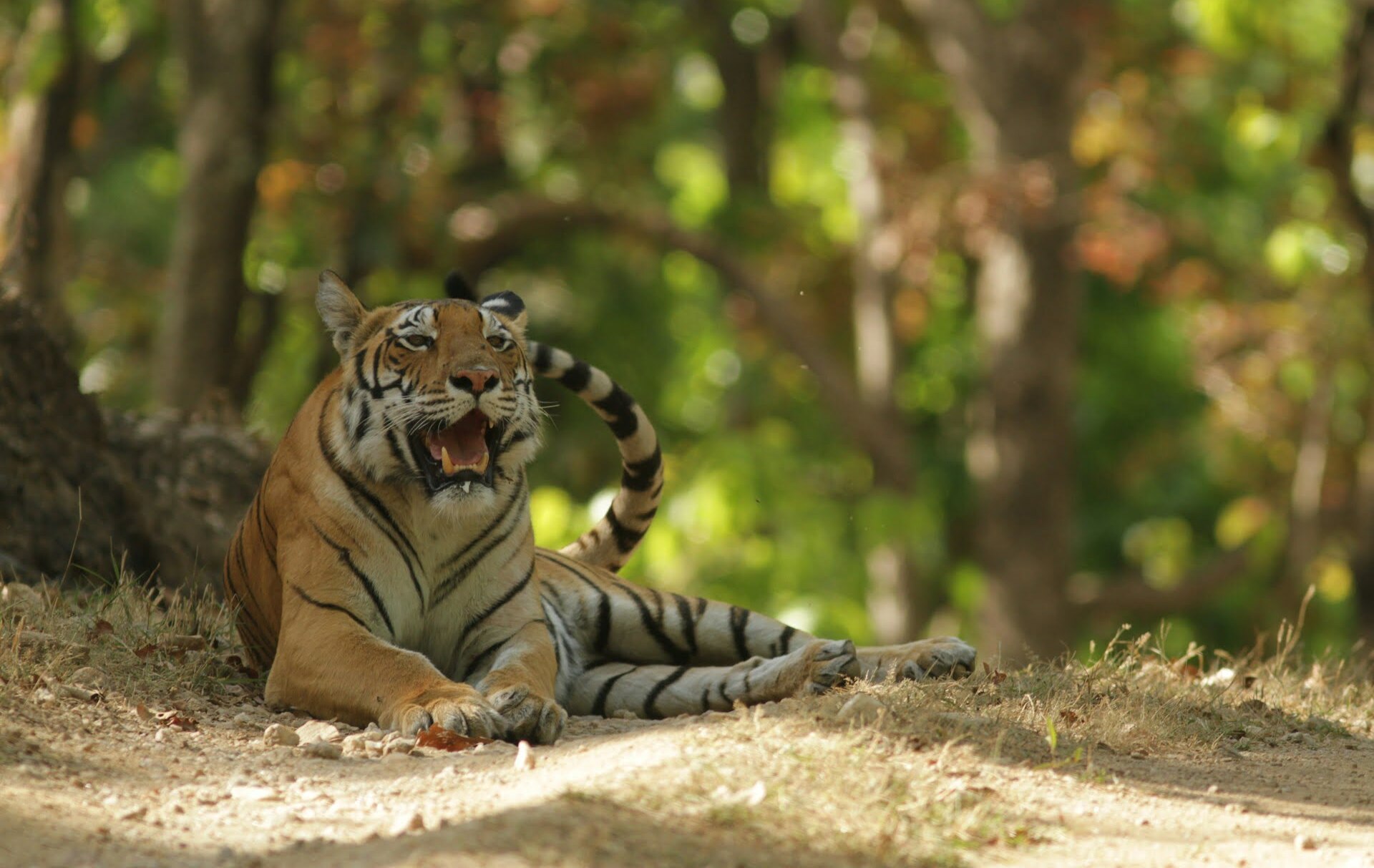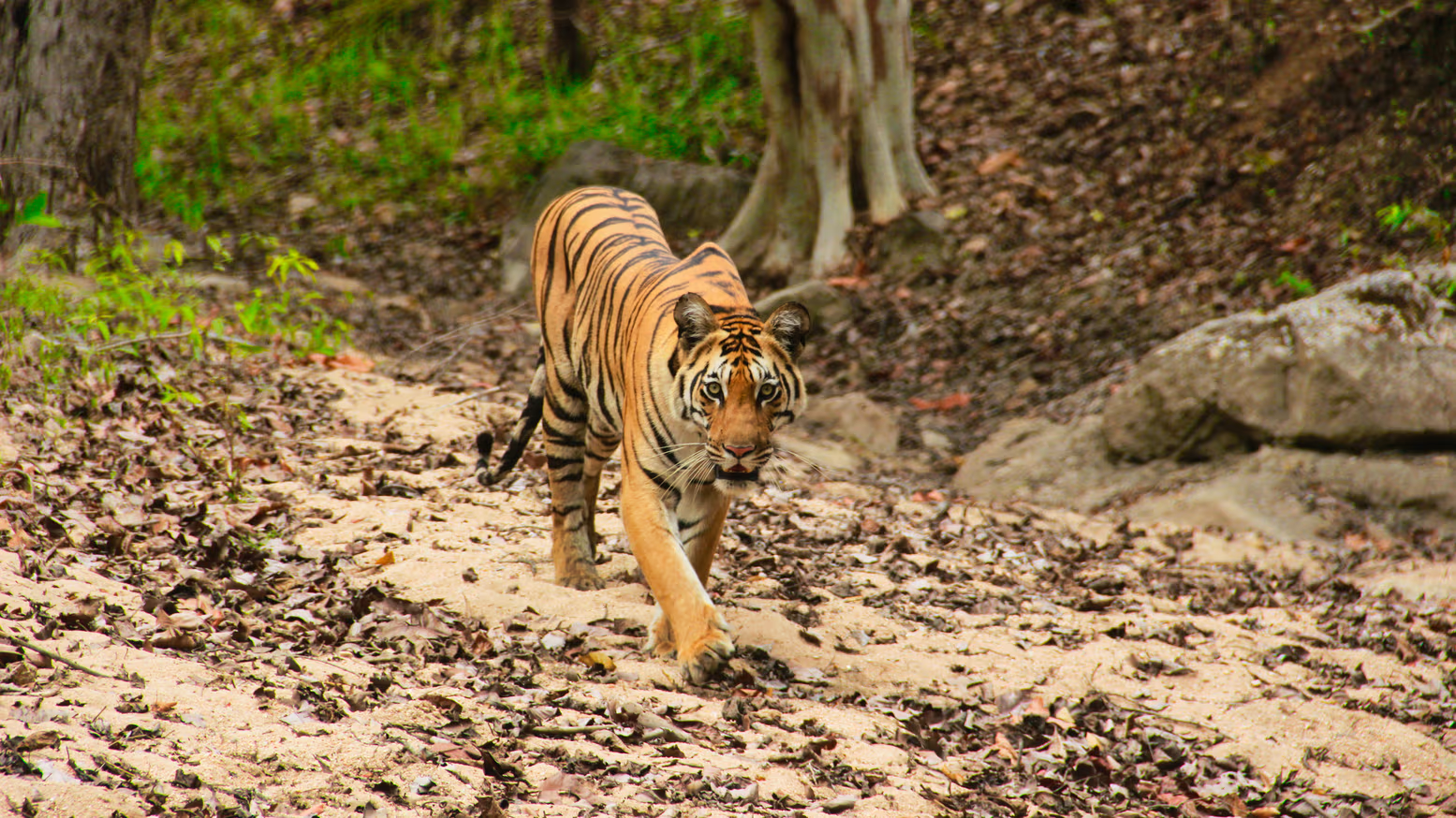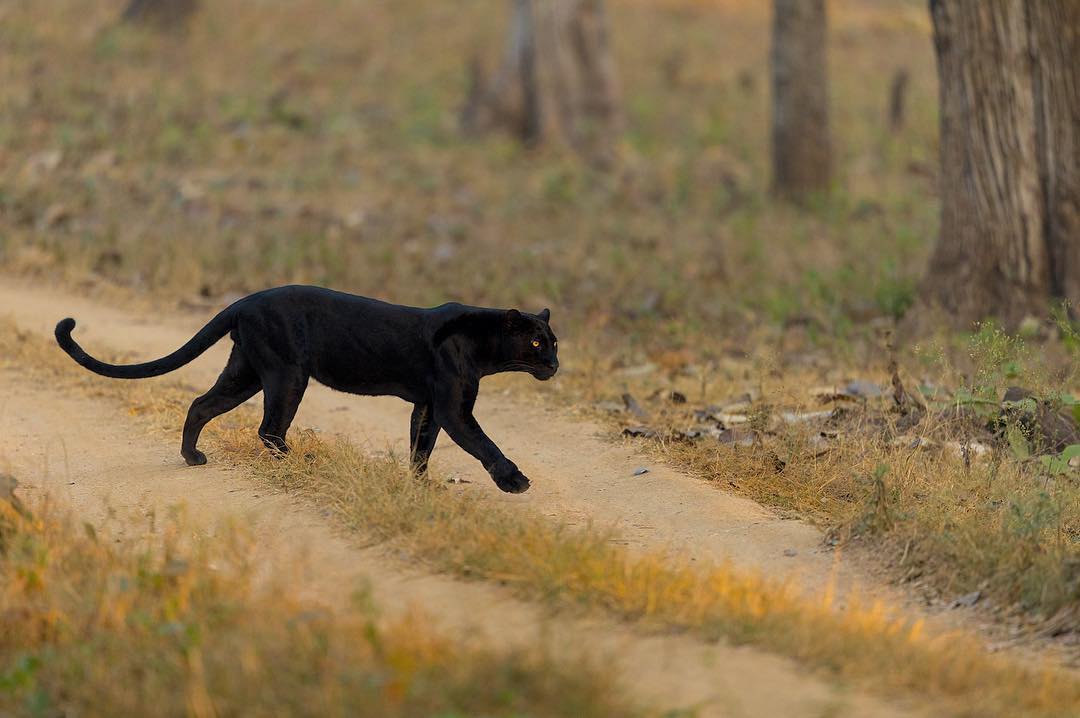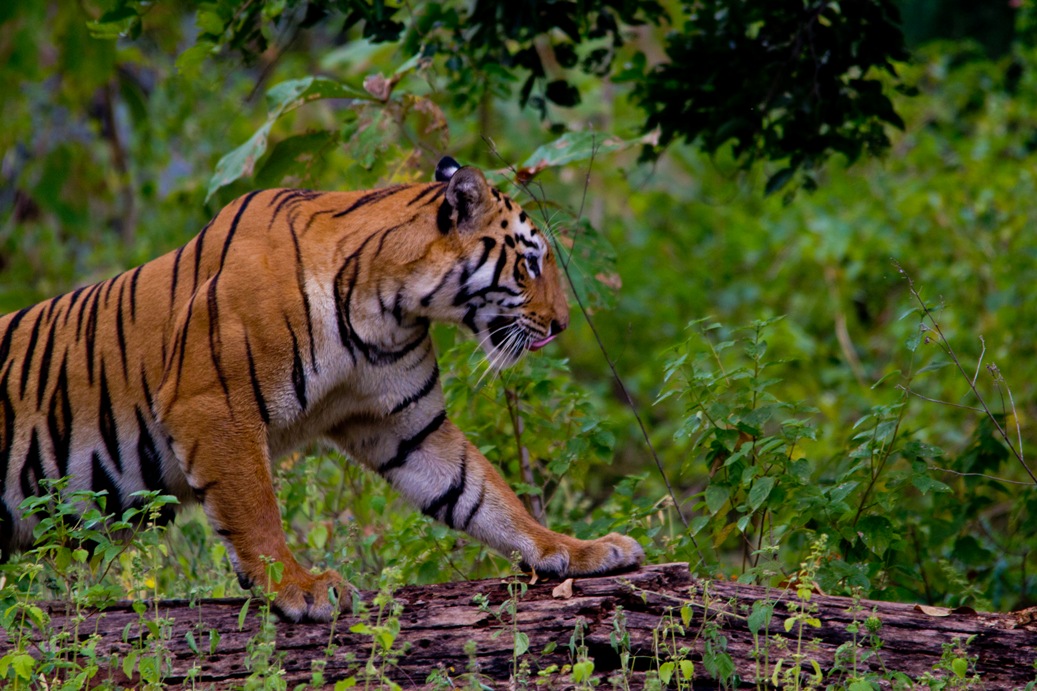The sloth bear (Melursus ursinus) stands out as one of India’s most unique wild animals. Unlike other bear species, sloth bears are insect-eaters, best known for their shaggy black coat, long snout, and strong digging claws. They may look a bit odd at first, but they’re powerful, quick on their feet, and fiercely defensive when startled.
These bears live in forests, grasslands, and rocky hills across India. However, their numbers are going down due to shrinking habitats and frequent run-ins with people. They are currently listed as Vulnerable on the IUCN Red List, which means their protection is more important than ever. This page takes you closer to their world and shows you where and how to spot them in India.
Physical Characteristics & Adaptations
- Size & Build: Adult sloth bears measure between 150-180 cm in length and weigh 55-140 kg, with males being larger than females.
- Distinct Appearance: They have shaggy black fur, a light-colored snout, and a unique V-shaped chest patch.
- Long Claws for Digging: Their curved, 3 inch long claws are designed for breaking termite mounds and digging into the ground.
- Specialized Lips & Teeth: Unlike other bears, sloth bears have missing upper front teeth, allowing them to suck up insects like a vacuum!
- Excellent Climbers: Despite their stocky build, sloth bears are agile climbers and often retreat to trees when threatened.
Key Characteristics Table of Sloth Bear
| Characteristic | Description |
|---|---|
| Scientific Name | Melursus ursinus |
| Common Name | Sloth Bear, Indian Bear, Labiated Bear |
| Head-body length | 1.4-1.9 meters |
| Shoulder height | 60-92 cm |
| Weight | Males: 80-145 kg (176-320 lbs); Females: 55-105 kg (121-231 lbs) |
| Habitat | Tropical forests, scrublands, grasslands. |
| Diet | Primarily termites and ants; also fruits, flowers, honey. |
| Social Behavior | Mostly solitary (except mothers with cubs on back). |
| Activity | Primarily nocturnal; does not hibernate. |
| Conservation Status | Vulnerable (IUCN). |
Diet and Feeding Habits
Sloth bears may look like their meat-eating cousins, but their diet is very different. They mostly feed on insects and forest fruits. Here’s what they usually eat:
- Termites and ants: These are their top choice. Sloth bears dig into mounds with their strong claws and suck out the insects using their long lips, making loud sniffing and snorting sounds while feeding.
- Fruits and berries: They enjoy seasonal fruits like wild mangoes, figs, jamun, and berries. These help them stay full during the warmer months.
- Honey: They are not afraid to raid beehives. They climb trees, knock down hives, and dig in for the honey and larvae.
- Occasional meat: Though they don’t hunt, sloth bears may feed on dead animals or very small creatures if they come across them.
Their feeding habits help control insect populations and spread seeds through their droppings, which supports healthy forests.
Habitat & Lifestyle
Sloth bears live in dry forests, grasslands, and rocky hills across much of India. They prefer areas where termite mounds are plenty and fruit trees grow naturally. These habitats offer both food and shelter, with caves, hollow tree trunks, or dense undergrowth often used for resting during the day.
They are mostly nocturnal, meaning they rest during the hot hours and become active at dusk. At night, they search for insects, fruits, or honey. During the warmer months, they often visit waterholes to cool off or drink.
Even though they can cover large distances while foraging, sloth bears tend to stay within a home range. They do not defend a fixed territory but avoid each other unless it’s mating season or a mother is raising cubs. While they’re usually seen alone, a mother with cubs is a common sight in the wild, with cubs riding on her back, especially when they are young.
Their ability to climb trees, dig into hard ground, and break open termite mounds shows how well they’ve adapted to their surroundings. Despite being shy and mostly hidden, sloth bears play an active part in the forest’s night life.
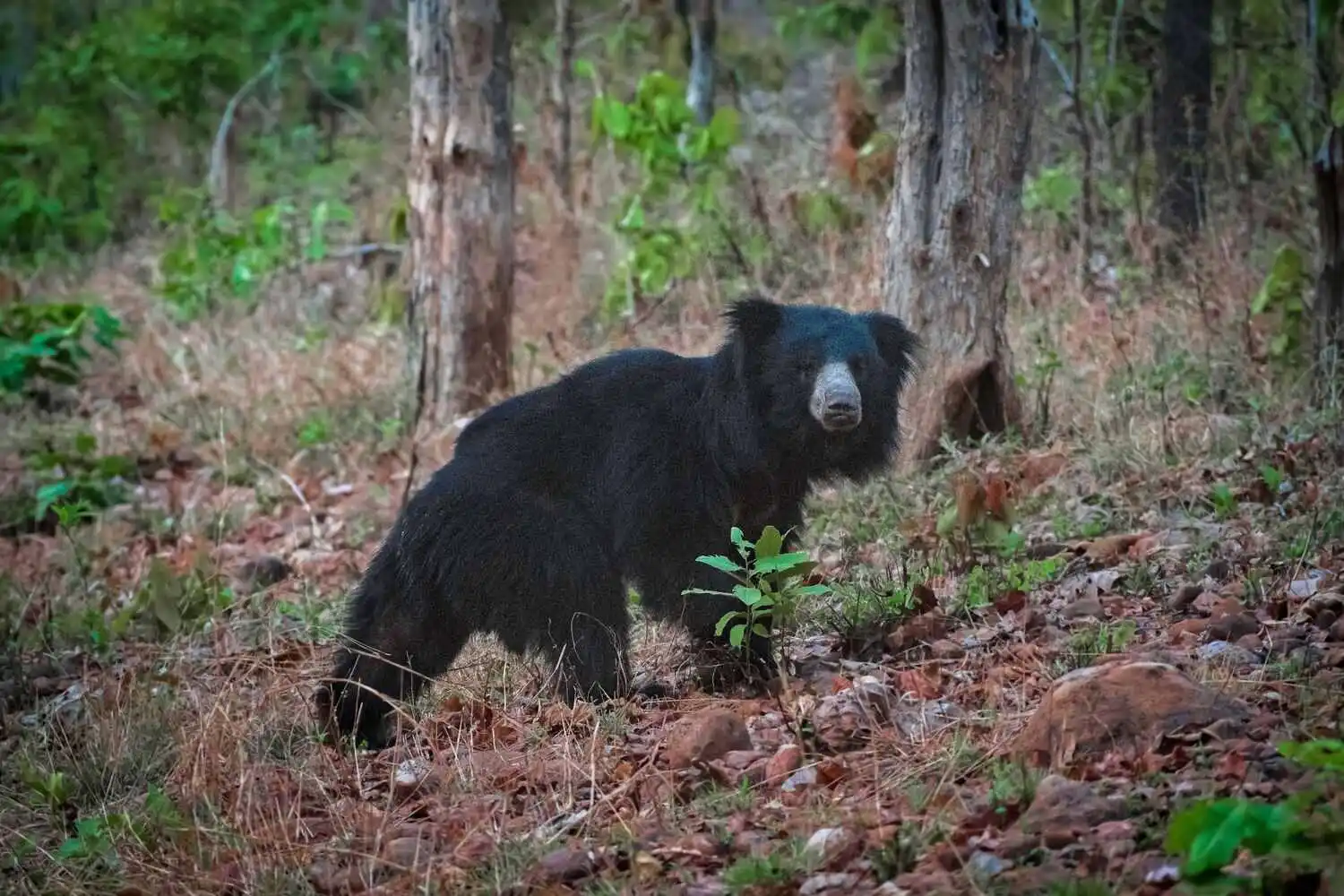
Where Sloth Bears Are Found in India
Sloth bears are spread across the Indian subcontinent, with healthy populations in central and southern India. They prefer forested areas with enough food and shelter. Though they’re shy, they adapt well to different landscapes such as dry scrublands, sal forests, and rocky outcrops. While sightings can be unpredictable, a few national parks and reserves offer good chances of spotting them.
Top National Parks to Spot Sloth Bears
- Satpura National Park, Madhya Pradesh: A top spot to see sloth bears. The mixed forest and rocky land make sightings common.
- Daroji Sloth Bear Sanctuary, Karnataka: India’s only sloth bear sanctuary. Best seen early morning or evening near Hampi.
- Kanha National Park, Madhya Pradesh: Known for tigers, but also home to many sloth bears in forest and grassland areas.
- Nagarhole and Bandipur, Karnataka: Good bear presence. Look out for claw marks and dug-up soil during your safari.
- Tadoba Andhari Tiger Reserve, Maharashtra: Dry forests offer good chances, especially in summer when bears come out more.
- Sanjay Dubri National Park, Madhya Pradesh: Quiet park with good bear numbers. Great for peaceful wildlife spotting.
These parks offer some of the best opportunities to observe sloth bears in their natural environment. However, patience is key, as they are mostly active at night and often avoid humans.
Best Wildlife Safaris to see Sloth Bears
Behavior & Social Structure
Sloth bears are mostly shy and prefer to stay alone. They are solitary by nature, except during mating season or when a mother is raising her cubs. Unlike tigers or leopards, they avoid conflict and usually stick to themselves.
One of the most special things about sloth bears is their bond with their young. Mothers carry their cubs on their backs for several months, a rare sight among wild animals. Cubs stay with their mothers for nearly two years, learning how to find food and stay safe.
Though quiet by nature, sloth bears can be surprisingly aggressive if they feel threatened. They’ve been known to defend themselves fiercely from big cats or even humans if startled.
Sloth Bear Population and Conservation Status
The Sloth Bear is one of the most widespread bear species in the Indian subcontinent. India is home to the largest population of sloth bears in the world, with an estimated 15,000 to 20,000 individuals as per recent wildlife assessments.
They are mainly found in the forests of central India, the Western Ghats, and parts of the Eastern Ghats, with smaller populations in the Himalayan foothills and northeast. Within India, Madhya Pradesh, Karnataka, Chhattisgarh, and Odisha are considered strongholds for the species.
Although their population is relatively stable compared to other large mammals, sloth bears are classified as Vulnerable on the IUCN Red List. The major threats they face include habitat loss, human-wildlife conflict, poaching, and road accidents. Protecting forest corridors and reducing conflict in areas where villages border forests are key to their survival.
Human-Sloth Bear Conflict
Sloth bears are known for their unpredictable behavior, especially when they feel cornered. Over the years, this has led to serious conflicts between bears and people in parts of India.
Why Do Sloth Bear Attacks Happen?
- Surprise Encounters – Sloth bears can’t see well and often get startled when someone suddenly appears near them. When that happens, they react with force to protect themselves.
- Habitat Destruction – As forests are cleared for farming or roads, bears lose their homes. This forces them to wander into villages and towns in search of food.
- Crop Raiding – Bears are drawn to fruit farms and fields. When they raid crops, angry farmers may try to scare or harm them.
- Close Encounters with People – In areas where people hike, gather firewood, or work in the fields, the chances of bumping into a bear go up.
Impact of Conflict
- Injuries to People – Sloth bears injure hundreds of people every year, especially in states like Madhya Pradesh and Chhattisgarh.
- Retaliation by Villagers – When people or livestock are hurt, villagers sometimes kill the bear in revenge. This only adds to the drop in their population.
- Pressure from Human Activity – Illegal tree-cutting and building inside bear habitats make things worse, pushing bears closer to human settlements.
Conservation Efforts to Reduce Conflict
- Spreading Awareness – Teaching villagers how to avoid sudden bear encounters can lower the chances of attacks.
- Wildlife Corridors and Protected Zones – Forest officials are creating safe spaces where bears can live and move freely, without crossing into human areas.
- Rescue and Rehab Programs – Groups like Wildlife SOS step in to rescue injured or orphaned bears and give them proper care.
- Ending the Use of Dancing Bears – Sloth bears were once captured and forced to perform on the streets. Thanks to strong campaigns, that practice has stopped completely now.

Interesting Facts About Sloth Bears
- Sloth bears are NOT related to sloths! Early naturalists mistakenly thought they were slow-moving like sloths.
- They suck up termites so efficiently that they create loud, vacuum-like noises while feeding.
- Unlike most bears, sloth bears have longer hind legs, giving them a unique walking style.
- They stand up on their hind legs when threatened, making them look larger.
- Despite their size, they are incredibly fast runners and can outpace humans.
- Cubs stay with their mothers for up to two years, much longer than other bear species.
- Unlike tigers or leopards, sloth bears don’t roar they grunt, snort, and even scream when alarmed!
Sloth bears are one of India’s most unique and misunderstood animals. Despite their shaggy, almost comical appearance, they are strong, defensive, and play a vital role in the ecosystem. However, human-bear conflicts are on the rise, making conservation efforts critical for their survival.
Next time you’re on a safari, keep an eye out for these shy yet fascinating creatures, you might just spot one sucking up termites or ambling through the forest under the moonlight!

